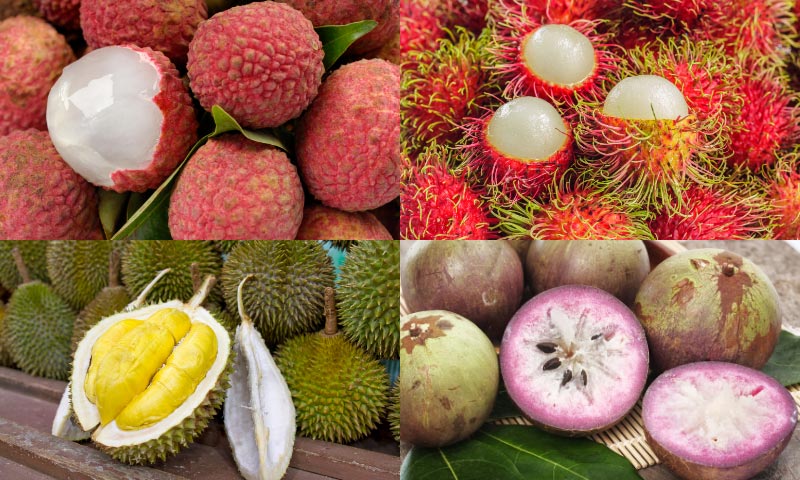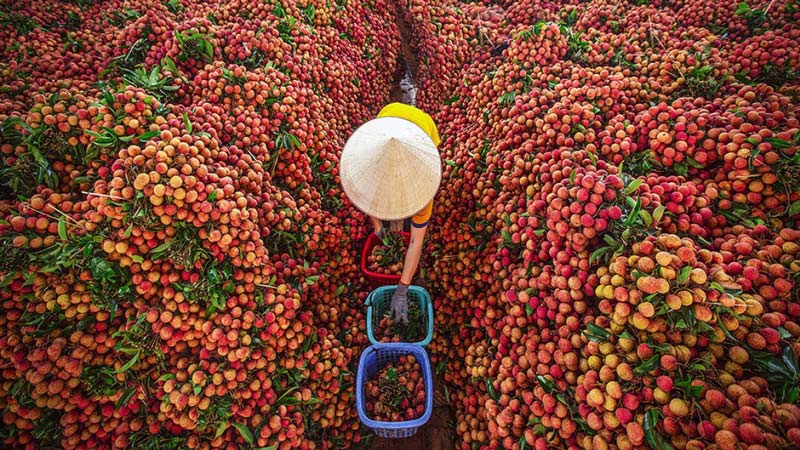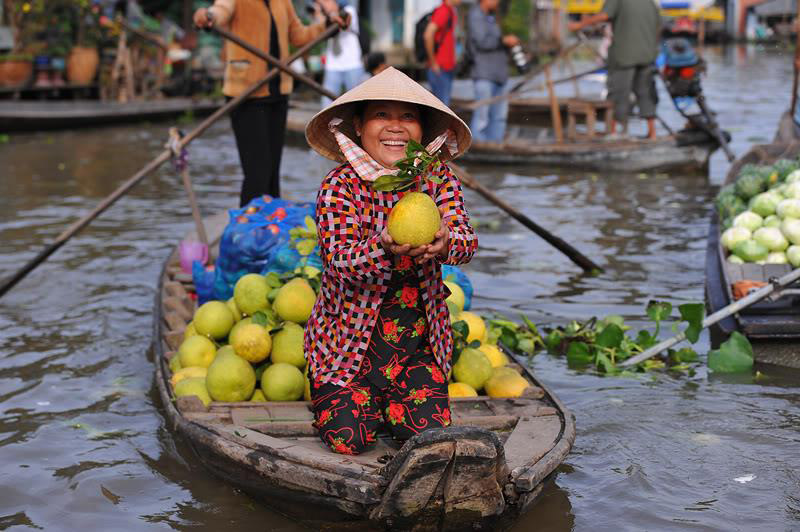Vietnam, a country celebrated for its breathtaking landscapes and vibrant culture, is also renowned for its diverse climate, making it an ideal haven for cultivating a myriad of tropical fruits. This Southeast Asian nation thrives on the richness of its land, offering an abundance of fresh fruit that not only symbolizes the country's agricultural heritage but also showcases its capacity to produce a vast array of flavors and textures. From the bustling markets in Ho Chi Minh City to the tranquil orchards in the Mekong Delta, Vietnam is truly a paradise for enthusiasts of fresh fruit, embodying the essence of both tradition and natural bounty.

Vietnam is a treasure trove of unique and exotic fruits, offering a plethora of flavors that are both intriguing and delightful. Among these, some stand out not only for their distinctive tastes but also for their fascinating appearances and stories.
Lychee (Vải): Often referred to as the "jewel of summer," the lychee holds a special place among the fruits of Vietnam. Its rough, red exterior conceals a translucent, pearly white flesh that is bursting with a sweet and floral aroma. Biting into a lychee is a symphony of flavors, with a perfect balance of sweetness and a subtle tang. The lychee's delicate taste and refreshing nature make it a beloved summer fruit, embodying the essence of Vietnamese warmth and hospitality.
Rambutan (Chôm chôm): The rambutan is a jewel among the fruits of Vietnam, easily recognizable by its vibrant red skin covered in soft, green-tipped spines. Beneath this spiky exterior lies a juicy, translucent flesh that is sweet with a slightly tart undertone, making rambutan Vietnam a must-try for fruit enthusiasts. The experience of peeling away the hairy skin to reveal the succulent fruit within is both unique and rewarding.
Longan (Nhãn): Referred to affectionately as the "dragon's eye" for its translucent flesh and dark seed that resemble an eyeball, the Vietnamese longan is a close relative of the lychee but boasts a sweeter flavor profile. This small, round fruit is encased in a thin, brown shell, and its delicate sweetness makes it a favorite snack across Vietnam. The Vietnamese longan not only tantalizes the taste buds but also captivates the imagination with its mystical appearance.
Mangosteen (Măng cụt): Revered as the "queen of fruits," the mangosteen holds a prestigious status among the fruits of Vietnam. Its thick, purple rind conceals a segmented white flesh that is incredibly refreshing and sweet, with a slight acidity that balances the flavor beautifully. The mangosteen's rich taste and cooling effect make it an exquisite treat, especially during the warmer months.
Durian (Sầu riêng): Often considered a challenge for the uninitiated due to its potent aroma, the Vietnamese fruit durian is a culinary adventure worth embarking on for the adventurous traveler. Its creamy, custard-like flesh contrasts sharply with its strong odor, offering a complex flavor profile that ranges from sweet to savory. This fruit is a testament to the adage, "Don't judge a book by its cover," or in this case, a fruit by its smell.
Star Apple (Vú sữa): The star apple, or milky fruit, is a hidden gem among Vietnamese fruits. When cut horizontally, it reveals a star-shaped pattern made by its seeds, surrounded by a milky, sweet flesh that is both refreshing and satisfying. This fruit is a testament to the diversity and uniqueness of Vietnamese agriculture, providing a taste that is as enchanting as its appearance.
Vietnam also presents familiar fruits in new and exciting ways, adding a distinctive Vietnamese twist that redefines their flavors.
Mango (Xoài): While mangoes are enjoyed worldwide, fruits in Vietnam offer a unique twist by incorporating them into a variety of dishes. From savory green mango salads, seasoned with fish sauce and chili, to sweet, ripe mangoes enjoyed as a refreshing dessert, the versatility of Vietnamese mangoes is unparalleled. Each dish showcases the fruit's ability to blend perfectly with both sweet and savory ingredients, making it a staple in Vietnamese cuisine.
Pomelo (Bưởi): The pomelo, known for its impressive size, is akin to the grapefruit but boasts a sweeter, more refined flavor. In Vietnam, the pomelo Vietnam is celebrated not just for its taste but for its role in traditional dishes and celebrations. Its sweet and slightly tangy flesh makes it a popular choice for salads, desserts, and even as a refreshing snack on its own.
Watermelon (Dưa hấu): A slice of watermelon is synonymous with relief from the heat, and in the hot Vietnamese climate, it's no exception. The melon Vietnam is cherished for its hydrating and refreshing qualities, making it the perfect fruit to enjoy during the sweltering summer months. Its crisp, sweet flesh offers a simple yet satisfying treat that is beloved by locals and travelers alike.
Vietnam's fruit landscape is as diverse as it is delicious, offering a rich palette of flavors that are sure to delight any palate. From the exotic to the familiar, each fruit tells a story of Vietnam's rich agricultural heritage, inviting travelers and food enthusiasts to explore and taste the bounty of this vibrant country.

Vietnam's vibrant fruit culture is as diverse as its landscapes, offering an abundance of flavors for anyone eager to explore the tastes of this Southeast Asian gem. Whether you're strolling through bustling city streets or wandering the serene countryside, the availability and variety of fruits in Vietnam are astounding. Here, we'll dive into the primary sources where these delicious fruits can be found: from the traditional fruit stands and markets to the more immersive Vietnamese fruit gardens.
In Vietnam, fruit stands and markets are more than just places to buy food; they're vibrant hubs of culture, color, and community. Scattered generously across cities and towns, these markets are where the local life pulses strongest. From the break of dawn, vendors lay out their colorful arrays of fruits, many of which are rare finds outside of Southeast Asia. Here, you can expect to see a spectrum of fruits in Vietnam, including the sweet and succulent lychee, the uniquely fragrant durian, the juicy dragon fruit, and the refreshing watermelon, among others.
What makes these markets special is not just the variety of fruits but also the opportunity to experience their freshness. Most of these fruits have been picked from nearby orchards and brought directly to the market, ensuring that you're getting the best quality. Moreover, wandering through these markets offers a chance to engage with local sellers, learn about the fruits' origins, and even pick up tips on selecting the best pieces.
For those looking for an even more authentic and hands-on experience, visiting a Vietnamese fruits garden offers a unique adventure. Throughout the country, numerous fruit gardens open their doors to visitors, providing a firsthand look at how these delicious fruits are grown. These gardens range from small family-owned plots to larger agricultural enterprises.
A visit to a Vietnamese fruit garden is not just about sightseeing; it's an educational journey into the heart of Vietnam's fruit cultivation practices. You can walk among the trees, learn about the different stages of growth, and, in many cases, taste the fruits directly from the branch. This experience not only brings you closer to the source of your food but also deepens your appreciation for the work involved in bringing these fruits to the table.

When traveling to Vietnam, indulging in the wide array of vibrant and exotic fruits available is an experience not to be missed. The "fruits of Vietnam" offer an unparalleled taste of the country's rich agricultural heritage and biodiversity. However, to fully enjoy these delightful offerings, it’s essential to keep in mind a few tips, especially regarding seasonal availability and the art of bargaining.
Vietnam, with its varied climates across different regions, is home to an extensive variety of fruits that are available at different times of the year. Seasonal fruits not only taste better but are also more affordable. For instance, the sweet and juicy lychee is best enjoyed from May to July, while the fragrant durian season peaks from June to August. Mangosteen, with its rich, tangy flavor, is typically available from May to September.
To choose the ripest and most flavorful fruits, look for vibrant colors and a firm yet slightly yielding texture. Fruits should feel heavy for their size, indicating juiciness. The aroma is also a key indicator of ripeness; the fruit should emit a distinct, pleasant smell. Engaging with local sellers can also offer insights into selecting the best produce; most are happy to share their knowledge and even let you sample before buying.
Exploring the local markets for fruits in Vietnam is an adventure in itself. While fixed-price supermarkets are common, traditional markets and street vendors often expect some level of bargaining. Prices are not always set in stone, and showing interest in buying multiple items or simply engaging in a friendly haggle can lead to a more favorable deal. It's a cultural practice that, when done respectfully, can enhance your shopping experience. However, it's important to approach bargaining with a sense of fairness and respect for the vendors, who rely on these sales for their livelihood.
Keep these tips in mind, and you're sure to enjoy the rich, delicious world of Vietnamese fruits to its fullest. Whether you're savoring a slice of dragon fruit, a bunch of longans, or the uniquely delicious jackfruit, each bite offers a taste of Vietnam's incredible natural bounty.

Vietnam, a country blessed with a climate that fosters the growth of a vast variety of fruits, offers an endless array of flavors that delight the palate. The fruits of Vietnam are not just a testament to the country's rich agricultural heritage but are a vibrant part of its cultural identity. From the sweet, succulent lychees to the tangy, refreshing taste of mangosteens, Vietnam's fruits embody the essence of tropical abundance and deliciousness.
While exploring the local markets or wandering through the lush orchards, travelers might also encounter a range of other fruits and vegetables that add to the country's culinary diversity. Apples, known locally as "vietnam apple fruit", may not be indigenous but have adapted well to the cooler regions, offering a crisp, refreshing taste. Similarly, cucumbers, or "cucumber in Vietnamese", are a staple in salads and side dishes, celebrated for their crunchy texture and hydrating properties.
The world of Vietnam fruits and vegetables is a realm of exploration that promises more than just a taste adventure; it's an insight into the country's agricultural innovation and sustainability. For travelers, it's an invitation to indulge in nature's bounty, to savor the flavors that are as diverse as the landscapes from which they emerge. Every visit to Vietnam is an opportunity to immerse oneself in the local culture, and there's no better way to start than by exploring the vibrant world of its fruits and vegetables.
So, to those setting foot on this beautiful land, let your curiosity guide you through the colorful markets, and let your taste buds embark on a journey that will, undoubtedly, be as enriching as it is delightful. Vietnam awaits to share its treasures, offering a slice of its natural beauty with every bite.